Navigation
Elephant Rescue Efforts Gaining Momentum
“Elephants across Africa and Asia are being poached for their ivory at increasing levels,” says WWF. Fortunately, there are many local human populations, national and international organizations and governments in the world often working together to save elephants and their habitats, groups in Asia and Africa, and even with elephant sanctuaries in the United States.
“Nature’s great masterpiece, an elephant,
The only harmless great thing.”
John Donne from “Progress of the Soul,” 1601 st. 39
 A family of African elephants in Amboseli National Park: note the protected position of the calves in the middle of the group: Photograph by Amoghavarsha Courtesy of Wikipedia
A family of African elephants in Amboseli National Park: note the protected position of the calves in the middle of the group: Photograph by Amoghavarsha Courtesy of Wikipedia
Elephants are some of the largest, gentlest, kindest and most intelligent creatures with whom we share the planet. This is not to say that elephants are never aggressive for they will, as most species, protect their territory and family and exhibit aggressive behavior during musth and they have even been used as war elephants. Artistic renderings of elephants have been found from 5,000 years ago.
They are deservedly beloved for their amiable qualities, exemplified by the Babar stories of Jean de Brunhoff depicting the close familiar relations among elephants.
“In the great forest a little elephant is born. His name is Babar. His mother loves him very much. She rocks him to sleep with her trunk while singing softly to him.” Thus starts The Story of Babar, a book about one of the world’s most beloved elephants. Written in 1931, and translated into 12 languages, response to this enduring story is illustrative of the strong positive sentiments young and old have for these majestic and largest of all land mammals.
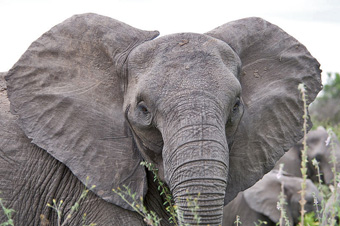 African elephant with ears spread in a threat or attentive position; note the visible blood vessels.: Photograph courtesy fo Wikipedia
African elephant with ears spread in a threat or attentive position; note the visible blood vessels.: Photograph courtesy fo Wikipedia
The enormous elephant ears are intriguing. They are not only powerful receptors of sound, capable of hearing at low frequencies, but also serve to remove excess body heat through their numerous blood vessels. When elephants are seen flapping their ears, it is likely that they are flapping them to remove excess body heat.
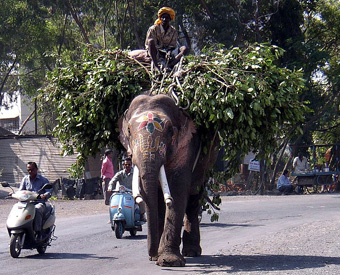
For thousands of years, elephants have been trained for use as work animals carrying people and huge loads on their backs, pulling wagons and hauling logs, and lifting enormous weights with their muscular trunks.
Their trunks popularized in stories pulling down trees spraying themselves and one another, the heart of ancient art and children’s elephant jokes, are quite incredible. With “more than 40,000 muscles and tendons” according to the Wildlife Conservation Society (WCS)…the trunk “can lift large objects, yet its sensitive tip can manipulate very small things.”
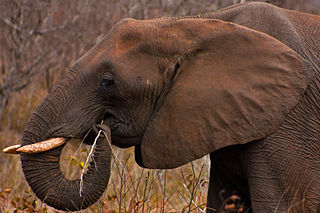 An African elephant in Kruger Park using its prehensile trunk for foraging: Photograph courtesy of Wikipedia.Their skill with their trunks, the tip of which is so sensitive that they can grab a single blade of grass, and their intelligence is put to use in Thailand ecotourist parks, among other places. There, elephants are taught to respond to a caretaker’s gentle manipulation of their ear, take a brush with the tip of their trunk, and proceed to paint paintings, guided by the caretaker. Their works of art are then sold to adoring crowds for funds to help with their maintenance. You can see them at work in the video included here (at the end of the article).
An African elephant in Kruger Park using its prehensile trunk for foraging: Photograph courtesy of Wikipedia.Their skill with their trunks, the tip of which is so sensitive that they can grab a single blade of grass, and their intelligence is put to use in Thailand ecotourist parks, among other places. There, elephants are taught to respond to a caretaker’s gentle manipulation of their ear, take a brush with the tip of their trunk, and proceed to paint paintings, guided by the caretaker. Their works of art are then sold to adoring crowds for funds to help with their maintenance. You can see them at work in the video included here (at the end of the article).
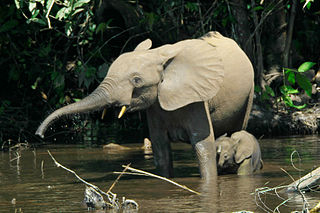 Forest elephants in the Mbeli River, Nouabalé-Ndoki National Park, Congo.: Photograph courtesy of Wikipedia.
Forest elephants in the Mbeli River, Nouabalé-Ndoki National Park, Congo.: Photograph courtesy of Wikipedia.
They suck up huge quantities of water at one time with their trunks, curve those mighty trunks around and spray it into their mouths. They drink as much as 40 liters (11 gallons) a day. They also use their trunks to spray water over their own bodies and that of their traveling companions, and, as humans’ also like to do, to spray one another in play.
Collecting grasses, twigs, bark, fruit and roots is done with their trunks helped by their tusks. They consume as much as 150 kg (330 pounds) of food a day.
Before writing about the elephants’ teeth, I will give you a couple accounts of elephants’ remarkable feats and of their importance as a keystone species.
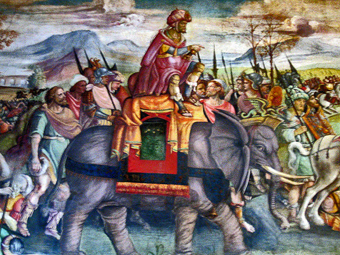 Hannibal in Italy, Fresco, Jacopo Ripanda (attr.), Beginning of 16th century Musei Capitolini, Rome, Italy: Image and related text courtesy of Wikipedia at en.wikipedia.org/wiki/Elephant.One of the amazing stories of the endurance of elephants is that of those crossing the Alps with Hannibal, a great military commander of ancient Carthage, in about 221 BC. Not only did the elephants climb the rugged, icy, hazardous Alps, but, according to recent numismatic [coin] evidence, they even ascended to within sight of the Matterhorn, one of the highest peaks in the Alps at over 14,600 feet.
Hannibal in Italy, Fresco, Jacopo Ripanda (attr.), Beginning of 16th century Musei Capitolini, Rome, Italy: Image and related text courtesy of Wikipedia at en.wikipedia.org/wiki/Elephant.One of the amazing stories of the endurance of elephants is that of those crossing the Alps with Hannibal, a great military commander of ancient Carthage, in about 221 BC. Not only did the elephants climb the rugged, icy, hazardous Alps, but, according to recent numismatic [coin] evidence, they even ascended to within sight of the Matterhorn, one of the highest peaks in the Alps at over 14,600 feet.
Another remarkable story is that of elephants rescuing humans in Burma. “British tea planter Gyles Mackrell organised the evacuation of hundreds of people from Burma into British India in 1942 in the face of the Japanese advance in South Asia,” related the BBC.
“Gyles Mackrell's own footage shows how elephants were used to rescue hundreds of refugees, stranded by flood waters in Burma in World War II. He was known as "The Elephant Man" in the newspapers of the time - but only now [2010] has the full story of one of World War II's most remarkable rescues come to light.”
Mackrell own video footage in which you can see the superb rescue operation is presented here with this article.
BBC quotes Dr Annamaria Motrescu of the Cambridge University Centre of South Asian Studies who said, “There was only one way Mackrell could save those whose flight from the enemy was blocked by monsoon-swollen rivers at the border - by elephant…. The Burmese capital Rangoon had fallen and tens of thousands of people, many of them sick or wounded, made the trek across hundreds of miles and through dense jungle in search of the safety of the Indian border. By May 1942, groups of evacuees were stranded on the banks of the narrow rivers dividing the two countries, torrential monsoon rains making the waters almost impossible to cross. The RAF dropped food supplies but the British were able to do little more.
“Mackrell, who had access to elephants through his work, was told about the situation on 4 June 1942 by a group who had managed to breach the Dapha River by forming a human chain while the water level was at a low.”
Mackrell wrote in his diary, which makes up part of the recently available Cambridge University collection: "I promised to collect some elephants and move off as quickly as I could as they told me the party behind would be starving, especially if they got held up by the rivers… After initially rescuing a group of 86 soldiers trapped on a mid-river island, about 200 people had been saved by September that year.”
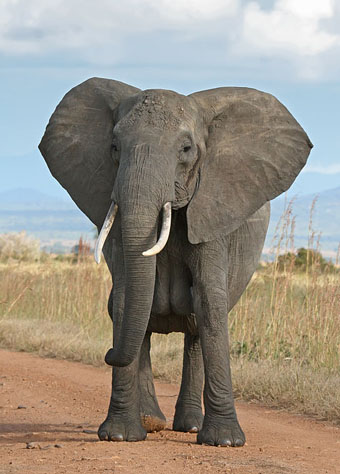 African elephant in Mikumi National Park, Tanzania: Photograph by Muhammad Mahdi Karim courtesy of WikipediaElephants’ great importance today is as a keystone species, a species as defined by the Encyclopaedia Britannica, as having a “large effect on the communities in which it occurs. Such species help to maintain local biodiversity within a community either by controlling populations of other species that would otherwise dominate the community or by providing critical resources for a wide range of species.”
African elephant in Mikumi National Park, Tanzania: Photograph by Muhammad Mahdi Karim courtesy of WikipediaElephants’ great importance today is as a keystone species, a species as defined by the Encyclopaedia Britannica, as having a “large effect on the communities in which it occurs. Such species help to maintain local biodiversity within a community either by controlling populations of other species that would otherwise dominate the community or by providing critical resources for a wide range of species.”
For example, WCS portrays the African savannah elephants, as having “large home ranges, spanning hundreds of square miles. As they move, they push over trees to get to their branches and roots, helping maintain the grasslands, and they use their tusks and trunks to dig for water, creating pools that many other animals need to survive.
“These elephants are important dispersers of seeds through their consumption of fruit.
“In folklore, elephants are known for not forgetting. For the African savannah elephant, memory is a tool for surviving challenges that may come intermittently over decades. Long-term memory tends to be vested in the older females, called matriarchs, without which the herd could die of starvation or dehydration. During the drought of 1993 in Tanzania, elephant matriarchs that remembered a similar drought 35 years before led their herds beyond the borders of Tarangire National Park in search of food and water. Groups with matriarchs that were not old enough to remember the previous drought suffered a 63 percent mortality of their calves that year.
Elephants Never Forget
An IFAW's 2011 Animal Action Education video available at IFAW Education Publications.
“In the past century, the number of elephants in the wild has declined by 50 per cent. Their disappearance could devastate ecosystems and have a lasting impact on the biodiversity of our planet. I hope this program will inspire and empower you to help protect elephants worldwide.” — Leonardo DiCaprio, Actor & Activist
“Unfortunately, these large females are the most attractive targets for ivory poachers. The animals tend to have the largest tusks, and they may be easier to find than the males.”
 Asian elephant debarking a tree with its tusks: Image and text by Yathin S Krishnappa courtesy of Wikipedia.Elephants have many teeth, usually 26, that grow in cycles throughout their lives, usually six times. New ones growing in the back of their mouths that come forward push out their old teeth.
Asian elephant debarking a tree with its tusks: Image and text by Yathin S Krishnappa courtesy of Wikipedia.Elephants have many teeth, usually 26, that grow in cycles throughout their lives, usually six times. New ones growing in the back of their mouths that come forward push out their old teeth.
The ones you see are their incisors that are known as tusks, ivory tusks. The tusks grow in their upper jaws and the part that is visible externally is just part of the tusk which is fastened to a socket in their skull.
“Elephants across Africa and Asia are being poached for their ivory at increasing levels,” says WWF. “The greatest threats facing elephants today are poaching, conflict with humans, and habitat loss and degradation.”
As many as 30,000 elephants are lost to poaching every year according to the WWF.
In just two of the New York Times articles about elephant loss this year, more than 91 elephants were reported killed: on 7 January, Poachers Kill 11 Elephants in Kenyan Park, and on 19 March elephant slaughter in Chad, reported by Reuters, Chad: Poachers Slaughter More Than 80 Elephants.
“Poachers killed at least 86 elephants in Chad last week, including 33 pregnant females and 15 calves, conservation groups said Tuesday, warning that elephants in Central Africa risked being wiped out by such slaughters. The killing was the worst in the region since more than 300 elephants were slaughtered in Cameroon early [in 2012]. Both raids took place during the dry season, when poachers armed with automatic weapons carry out coordinated attacks on herds of elephants in the region. The attack was reported to have taken place on 14 and 15 March in southern Chad, near the border with Cameroon. Citing local officials, the World Wildlife Fund said the poachers were on horseback and spoke Arabic, suggesting that they may have been the same group involved in the 2012 attack in northern Cameroon. Conservationists warn that criminal gangs are trafficking huge quantities of tusks to cash in on soaring demand for ivory in Asia.”
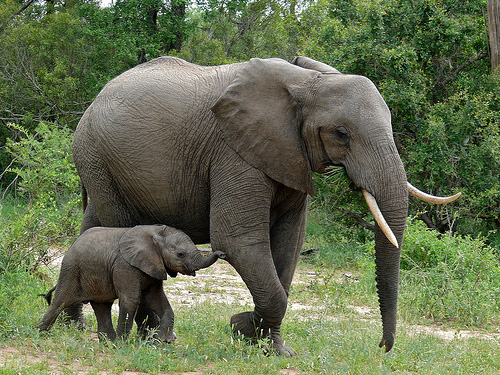 Loxodonta africana, elephant and baby in Kruger National Park, South Africa: Photograph by and © Bernard DUPONT courtesy of Flickr EOL images.
Loxodonta africana, elephant and baby in Kruger National Park, South Africa: Photograph by and © Bernard DUPONT courtesy of Flickr EOL images.
Slaughter of these majestic animals and killing of park rangers brought worldwide condemnation and strengthened actions for their protection.
Fortunately, there are many local human populations, national and international organizations and governments in the world often working together to save elephants and their habitats, groups in Asia and Africa, and even with elephant sanctuaries in the United States.
Mother Elephant Saves Baby From Drowning
“Mother elephant rescues baby from drowning in a waterhole and then gets stuck herself.” Location: Kruger National Park, South Africa. Winner of the 50/50 Veldfokus competition." Video taken by Mariaan de Klerk (www.mariaandeklerk.blogspot.com)
On 14 March of 2013, the WWF news headline coming from the Convention on the International Trade of Endangered Species (CITES) held in Bangkok, Thailand, read, “Governments start to rein in ivory and rhino horn trade, give sharks and timbers [woods] better protection at wildlife trade meeting.”
 An African elephant (Loxodonta africana): Photograph courtesy of CITESCountries, on the final day of the Convention “capped the historic two-week meeting by deciding for the first time to initiate a process requiring countries most implicated in illicit ivory trade to clamp down on smuggling,” stated WWF.
An African elephant (Loxodonta africana): Photograph courtesy of CITESCountries, on the final day of the Convention “capped the historic two-week meeting by deciding for the first time to initiate a process requiring countries most implicated in illicit ivory trade to clamp down on smuggling,” stated WWF.
Governments mandated 8 countries, China, Kenya, Malaysia, the Philippines, Thailand, Uganda, Tanzania and Viet Nam, the countries of highest concern in terms of their failure to clamp down on large-scale illegal ivory trade, to submit time-bound plans to deal with the problem in two months [by 14 May 2013], and make progress before the next CITES meeting in summer of 2014.
Under CITES rules, failure by those countries to take action could lead to a compliance process potentially resulting in sanctions being initiated. The treaty allows CITES to issue a recommendation that governments taking part in the treaty stop trading with non-compliant countries in the 35,000 species covered under the convention, from orchids to crocodile skins.
“After years of inaction, governments today put those countries failing to regulate the ivory trade on watch, a move that will help stem the unfettered slaughter of thousands of African elephants,” said Carlos Drews, head of WWF’s CITES delegation. “The gains made to better protect species here in Bangkok are a major milestone …but the fight to stop wildlife crime is not over. These countries will now be held accountable to these pledges, and must step up the urgency in dealing with the global poaching crisis that is ravaging our wildlife.”
These decisions to better regulate the ivory trade came after Thai Prime Minister Yingluck Shinawatra announced on the opening day of the CITES meeting that she would shut down her country’s ivory markets. More than 1.5 million people had signed petitions by WWF, Avaaz, and actor and conservationist Leonardo DiCaprio asking her to end the trading of ivory in Thailand.
At the Convention, governments also extended better protection to threatened rhinos, sharks and manta rays, and several species of rosewood and ebony.
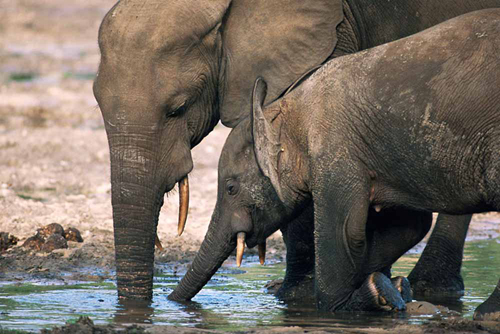 Forest elephants at water.: Photograph courtesy of WWF.
Forest elephants at water.: Photograph courtesy of WWF.
On 8 May 2013, CITES Secretary-General called for urgent action to protect elephants in the Dzanga-Sanga National Park from armed groups.
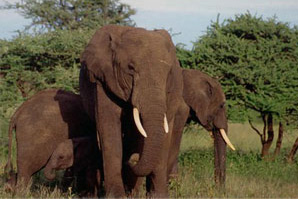 An African elephant (Loxodonta africana): Photograph courtesy of CITES
An African elephant (Loxodonta africana): Photograph courtesy of CITES
Grave concern over the recent reports of the deteriorating situation in the Central African Republic were expressed by John E. Scanlon, the Secretary-General of CITES.
Information suggests that armed groups have entered and may have started to massacre forest elephants in a World Heritage Site located in the southwestern corner of the country bordering Cameroon and the Republic of Congo.
According to the WWF and various media reports, a group of 17 individuals, some of them armed with heavy caliber rifles, entered the Dzanga-Ndoki National Park on 6 May 2013 and headed for the Dzanga Bai, locally known as the "village of elephants," a large clearing where between 50 and 200 elephants congregate every day to drink mineral salts present in the sands and where they are very vulnerable to human predators.
At the Dzanga-Ndoki National Park, monitored through the CITES-led Monitoring Illegal Killing of Elephants (MIKE), levels of poaching have generally been below average for Central Africa. The site is remote and has been relatively well protected and there have been no major poaching incidents until now.
The CITES Secretariat urged all governments of the region, United Nations and other international bodies to take urgent action to prevent the massacre of the elephant population living in the park. CITES also informed its partners in the International Consortium on Combatting Wildlife Crime (ICCWC) of the imminent threat and requested each one to reach out and inform their various networks.
Recent poaching incidents of elephants have been on a massive scale, “reflecting a new trend across the African continent where well-armed poachers with sophisticated weapons decimate one of our most magnificent species, often with impunity,” said Scanlon. “This imminent threat to elephants in a remote and relatively well protected area is of grave concern to CITES and I call on the international community to join forces and take coordinated action to avoid a new tragedy of similar proportions to the massive killing of elephants [that] occurred in Cameroon in 2012."
In April, the park allegedly suffered repeated attacks during which equipment was looted from the administration buildings and facilities were destroyed. Scanlon said, "The alarm sounded by UNESCO 's Director General, Ms Irina Bokova, further reinforces our concerns about the links between illicit wildlife trafficking and regional security in parts of Africa. The CITES Secretariat will continue to support authorities investigating and combatting the involvement of rebel militias in wildlife crime as may be required."
CITES reported on the increasing incidents of poaching in World Heritage sites across Africa to the 16th meeting of the Conference of the Parties in Bangkok in March. Last year, in August 2012, the Secretariat engaged in discussions with UNESCO to explore areas for increased collaboration between UNESCO and CITES, in particular with regard to elephant poaching and illegal ivory trade.
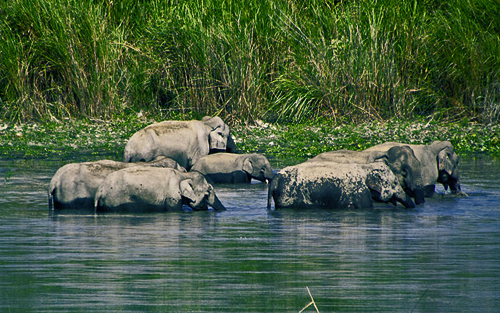 A family of elephants bathing, a behavior which reinforces social bonding: Photograph by Arnabjdeka Courtesy of Wikipedia
A family of elephants bathing, a behavior which reinforces social bonding: Photograph by Arnabjdeka Courtesy of Wikipedia
Several conservation areas, including the Garamba National Park and Okapi Wildlife Reserve, mentioned in CITES reports on illegal killing of elephants are UNESCO world heritage sites.
The strategic and operational decisions taken on enforcement matters at the last CITES (CoP16) provide a strong basis for countries to take concrete action to put an end to the current high levels of illegal wildlife trade.
Range States are currently experiencing a serious spike in the illegal killing of African elephants and rhinos and the related illegal trade in ivory and rhino horn. Data compiled from the program CITES MIKE suggests an ongoing increase in levels of illegal killing of elephants since 2006, with 2011 displaying the highest levels of poaching since MIKE records began in 2002. These findings are supported by information available from the Elephant Trade Information System (ETIS), which indicates that the amount of seized ivory has continued to escalate and is currently at its highest level in the 16-year period examined by ETIS.
The illegal killings of large numbers of elephants for their ivory are increasingly involving organized crime and, in some cases, well-armed rebel militias. For example, in Bouba N'Djida National Park, in northern Cameroon, up to 450 elephants were allegedly killed by rebel groups from Chad and Sudan in February 2012.
The poached ivory is believed to be exchanged for money, weapons and ammunition to support conflicts in neighboring countries.
In response to this insurgence, the Government of Cameroon deployed up to 150 soldiers into the National Park in support of park rangers to put an end to the illegal killing.
Twenty-two elephants in the Garamba National Park, Democratic Republic of the Congo, were apparently shot from a helicopter with a high level of marksmanship and in a single raid. The ivory was taken away.
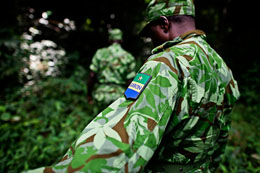 Anti-poaching patrol, Gabon: Photograph © WWF-Canon / James MorganPoaching levels increased in all African subregions, with central Africa continuing to display the highest levels of illegal killing in any subregion in Africa or Asia.
Anti-poaching patrol, Gabon: Photograph © WWF-Canon / James MorganPoaching levels increased in all African subregions, with central Africa continuing to display the highest levels of illegal killing in any subregion in Africa or Asia.
Wildlife rangers who are serving in the front-line are often quite literally being outgunned.
Wildlife crime has become a serious threat to the security, political stability, economy, natural resources and cultural heritage of many countries and that the extent of the response required to effectively address this threat are often beyond the sole remit of environmental or wildlife law enforcement agencies, or of one country or region alone.
This critical situation demonstrates the need of implementing the African Elephant Action Plan that was created under the auspices of CITES.
An African Elephant Fund was launched last August at the 61st meeting of the CITES Standing Committee and is managed by the United Nations Environment Programme (UNEP).
Tsavo Elephant Census 2011 Video
Exploring what goes into, and what comes out of, the efforts to count elephants in Tsavo National Park, Kenya. Uploaded 25 July 2011
On 16 May 2013, The Secretariat of the Convention on International Trade in Endangered Species of Wild Fauna and Flora (CITES) reports receiving National Ivory Action Plans from the eight countries identified as primary source, transit and import countries affected by illegal trade in ivory: China, Kenya, Malaysia, the Philippines, Thailand, Uganda, the United Republic of Tanzania and Viet Nam and requested those countries to take urgent measures to implement their plans by July 2014 when the CITES Standing Committee will review their implementation.
Each plan specifies activities in the areas of legislation and regulations, national and international enforcement, outreach and public awareness.
“Full implementation of the landmark decisions that CITES member States adopted by consensus last March to combat wildlife crime, together with the complementary decisions taken by the CITES Standing Committee, is key to winning the fight against illegal wildlife trade. The CITES Secretariat will continue to support CITES Parties in their efforts and to rally further political and financial support to assist them with on-the-ground implementation,” said Scanlon.
CITES will work closely with the countries concerned in monitoring their implementation. In July 2014, the Secretariat will provide the Standing Committee with its evaluation of the activities conducted by each country and recommend potential further measures to intensify efforts in critical areas.
 260 wikipedia Gabon.jpg) Male forest elephant at the Langoué Bai (forest clearing), Ivindo National Park, Gabon.: This male came to the clearing to drink mineral-rich water, obtained from pits dug by elephants at specific locations within the clearing. Photograph by Peter H. Wrege courtesy of WikipediaThe deliberations in March also identified two additional groups of countries that need to adopt measures in the near future. The first group, Cameroon, the Congo, the Democratic Republic of the Congo, Egypt, Ethiopia, Gabon, Mozambique and Nigeria, will need to develop and start implementing similar National Ivory Action Plans in the course of this year. The second group, Angola, Cambodia, Japan, the Lao People's Democratic Republic, Qatar and the United Arab Emirates, have been instructed by CITES to seek provide reports on how they control trade in ivory.
Male forest elephant at the Langoué Bai (forest clearing), Ivindo National Park, Gabon.: This male came to the clearing to drink mineral-rich water, obtained from pits dug by elephants at specific locations within the clearing. Photograph by Peter H. Wrege courtesy of WikipediaThe deliberations in March also identified two additional groups of countries that need to adopt measures in the near future. The first group, Cameroon, the Congo, the Democratic Republic of the Congo, Egypt, Ethiopia, Gabon, Mozambique and Nigeria, will need to develop and start implementing similar National Ivory Action Plans in the course of this year. The second group, Angola, Cambodia, Japan, the Lao People's Democratic Republic, Qatar and the United Arab Emirates, have been instructed by CITES to seek provide reports on how they control trade in ivory.
The illegal killing of large numbers of elephants for their ivory is increasingly involving organized crime and, in some cases, well-armed rebel militias. Unknown amounts of poached ivory are believed to be exchanged against money, weapons and ammunition to support conflicts in several African countries.
Significant poaching incidents have recently occurred in Bouba N’Djida National Park in Cameroon, Garamba National Park in the Democratic Republic of the Congo, and Dzanga-Ndoki National Park in the Central African Republic. The CITES Secretariat has also informed its partners in the International Consortium on Combatting Wildlife Crime (ICCWC) of the imminent threat to elephants in the Dzanga-Ndoki National Park and requested each one to reach out and inform their various networks.
On 1 July 2013, WCS reported the organization responded to increased poaching and killing of elephants in South Sudan by expanding efforts to protect remaining elephants: “South Sudan Expands Efforts to Protect Remaining Elephants: South Sudan’s Ministry of Wildlife Conservation and Tourism and WCS collar elephants with GPS/Satellite units to monitor & protect their populations.”
.jpg) Ministry and WCS team fixing collar on adult male elephant, Republic of South Sudan.: Photograph© Rob Craig WCSWith expert assistance from the Wildlife Conservation Society and funding from USAID, South Sudan’s Ministry of Wildlife Conservation and Tourism (MWCT) has ramped up efforts to protect its last elephants by fitting individual animals with GPS collars for remote tracking, a critical practice in the fight against ivory poachers.
Ministry and WCS team fixing collar on adult male elephant, Republic of South Sudan.: Photograph© Rob Craig WCSWith expert assistance from the Wildlife Conservation Society and funding from USAID, South Sudan’s Ministry of Wildlife Conservation and Tourism (MWCT) has ramped up efforts to protect its last elephants by fitting individual animals with GPS collars for remote tracking, a critical practice in the fight against ivory poachers.
In late May and early June, participants from WCS and MWCT succeeded in collaring elephants to track and monitor the majority of South Sudan’s remaining populations, which collectively are estimated to total fewer than 5,000 elephants, down from the 80,000 thought to inhabit the region in the 1960s-70s.
Elephant herds in South Sudan were decimated during years of civil war and the survivors are under increasing threat due to insecurity and an increase in ivory poaching. The situation has been made worse by the presence of rebel groups in the sub-region, including the Lord’s Resistance Army, which have poached elephants and trafficked ivory as means of sustaining their operations, according to confirmed reports.
.jpg) (Left to Right) Minister Gabriel Changson, Field Veterinarian Dr. Mike Kock, WCS’s Michael Lopidia collaring adult: female elephant, Republic of South Sudan. Photograph© Paul Elkan WCSThe GPS/satellite tracking effort is part of a USAID/WCS funded elephant monitoring and protection program launched in 2009, an initiative that also includes surveillance from planes, land-based anti-poaching patrols, and intelligence-led enforcement.
(Left to Right) Minister Gabriel Changson, Field Veterinarian Dr. Mike Kock, WCS’s Michael Lopidia collaring adult: female elephant, Republic of South Sudan. Photograph© Paul Elkan WCSThe GPS/satellite tracking effort is part of a USAID/WCS funded elephant monitoring and protection program launched in 2009, an initiative that also includes surveillance from planes, land-based anti-poaching patrols, and intelligence-led enforcement.
“I salute the efforts and bravery of the Government of South Sudan’s wildlife personnel and WCS staff who are working to protect wildlife and manage protected areas in these remote zones,” said Dr. Cristián Samper, President and CEO of WCS. “The recent expansion of the South Sudan elephant monitoring and protection program is evidence of the serious measures and commitment needed to help secure the country’s protected areas and wildlife for the benefit of the people and new nation.”
Dr. Paul Elkan, WCS’s South Sudan Country Director, said: “The elephant collaring is critical to improving our understanding of the location and movements of South Sudan’s elephants and providing effective protection. Real-time location data from the collared elephants, combined with aerial surveillance, intelligence-led enforcement, and terrestrial patrolling, will enable the MWCT and WCS to watch over the safety of the elephant groups, detect poaching threats, target anti-poaching operations to arrest poachers and traffickers, and secure the elephants.”
.jpg) Adult male elephant waking up after immobilization and collaring, Republic of South Sudan.: Photograph © Paul Elkan WCSThe elephant collaring operation, undertaken by WCS experts and staff of the Ministry with the support of a helicopter and two WCS survey aircraft, successfully completed the objective of covering the majority of the remaining elephant populations across the country. The team, however, was unable to immobilize and collar elephants in the Boma National Park area where armed conflict prevented access. These remaining elephant groups will be collared later in the year, security permitting.
Adult male elephant waking up after immobilization and collaring, Republic of South Sudan.: Photograph © Paul Elkan WCSThe elephant collaring operation, undertaken by WCS experts and staff of the Ministry with the support of a helicopter and two WCS survey aircraft, successfully completed the objective of covering the majority of the remaining elephant populations across the country. The team, however, was unable to immobilize and collar elephants in the Boma National Park area where armed conflict prevented access. These remaining elephant groups will be collared later in the year, security permitting.
“The presence of these elephants breathes life and value into our national parks,” said the Hon. Gabriel Changson Chang, Minister of Wildlife Conservation and Tourism, who joined the collaring operation in Nimule National Park and fixed a collar on an adult female elephant. “We must do everything in our means to protect these magnificent creatures. It is our wildlife that will be the basis for developing tourism that will attract visitors from all over the world to South Sudan.”
Monica Moore, USAID South Sudan’s Chief of the Office of Transition and Conflict Mitigation, who oversees USAID support to the conservation programs in the country, said: “Monitoring and protection of the elephant populations is essential for conservation and directly contributes to improving governance and security in remote areas of the country. The involvement of armed groups in ivory poaching, trafficking, and local conflicts in and around protected areas is well documented in Africa. USAID’s support to the MWCT and WCS efforts in South Sudan combines conservation and conflict reduction objectives to help improve security for both people and wildlife, while securing the foundation for development of the new country.”
.jpg) Elephant standing up after immobilization and collaring, Republic of South Sudan.: Photograph© Paul Elkan WCSDuring the extensive aerial efforts to locate and track elephant groups, the team also collected systematic data on the relative abundance and distribution of other large animals including hippos, Nile lechwe (a species of antelope), shoebill (a species of stork-like bird), giraffes, buffalos, migratory antelopes, and other species. Information on human activity in and around the protected areas and wildlife corridors was gathered as well. The wildlife tracking program is also monitoring GPS/satellite collars previously deployed on key migratory antelope species white-eared kob, tiang, and giant eland. This data will directly contribute to the implementation of effective wildlife protection measures that will address elephant poaching and the escalating commercial bushmeat trade in South Sudan, and inform the design of protected area management and tourism strategies.
Elephant standing up after immobilization and collaring, Republic of South Sudan.: Photograph© Paul Elkan WCSDuring the extensive aerial efforts to locate and track elephant groups, the team also collected systematic data on the relative abundance and distribution of other large animals including hippos, Nile lechwe (a species of antelope), shoebill (a species of stork-like bird), giraffes, buffalos, migratory antelopes, and other species. Information on human activity in and around the protected areas and wildlife corridors was gathered as well. The wildlife tracking program is also monitoring GPS/satellite collars previously deployed on key migratory antelope species white-eared kob, tiang, and giant eland. This data will directly contribute to the implementation of effective wildlife protection measures that will address elephant poaching and the escalating commercial bushmeat trade in South Sudan, and inform the design of protected area management and tourism strategies.
Information from GPS/tracking, aerial surveys, and socio-economic surveys with local communities are also informing a country wide protected area network assessment WCS is undertaking with the Ministry, with support from USAID and UNDP/ GEF, to optimize the network’s coverage to conserve the remaining wildlife and habitat resources. The assessment includes: proposing the creation of new protected areas and corridors; realigning boundaries of existing ones; and degazetting some protected areas that have lost their conservation value.
“During the operation we identified three new pristine areas providing critical habitat for endangered wildlife populations which warrant new protected area status,” added Dr. Elkan.
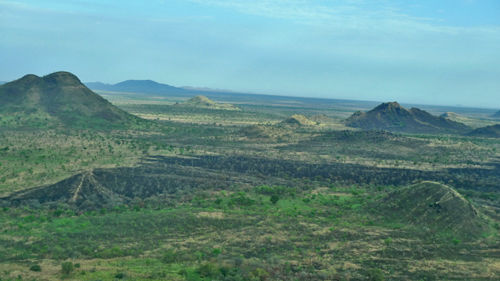 The Boma Plateau is a very strategic outpost where you can see for hundreds of kilometers in all directions as seen from this sh: Photograph courtesy of the Borlaug Institute
The Boma Plateau is a very strategic outpost where you can see for hundreds of kilometers in all directions as seen from this sh: Photograph courtesy of the Borlaug Institute
Recent insecurity in the Boma National Park has brought tragedy and suffering to the areas in and around the protected area, creating an obstacle to tourism development there in the near future. In April and May of 2013 the armed conflict between a rebel militia group and the government’s armed forces reached the eastern sector of the park, resulting in tragic loss of life, displacement of many people, and destruction of park infrastructure.
The Boma National Park Warden Brig. Kolor Pino, three wildlife rangers, and two policemen were killed in the line of duty while traveling to the park headquarters.
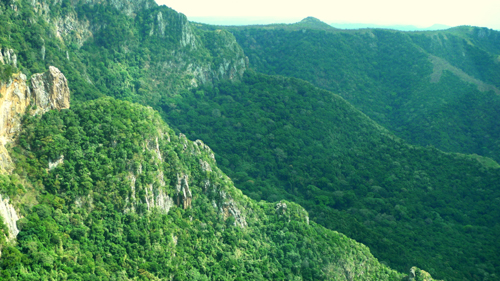 This photo shows the dense forests on the eastern side of the Boma Plateau where coffee originated and is still growing.: The Kachipo people who inhabit the dense forests not only gather the wild coffee for their own use and trade, but they also plant seedlings in and around their village for increased productivity and efficiency in harvesting. The Borlaug Institute and the Global Coffee Quality Research Initiative would like to thank the Wildlife Conservation Society for providing intelligence and vehicles for this mission. Photograph courtesy of the Borlaug Institute
This photo shows the dense forests on the eastern side of the Boma Plateau where coffee originated and is still growing.: The Kachipo people who inhabit the dense forests not only gather the wild coffee for their own use and trade, but they also plant seedlings in and around their village for increased productivity and efficiency in harvesting. The Borlaug Institute and the Global Coffee Quality Research Initiative would like to thank the Wildlife Conservation Society for providing intelligence and vehicles for this mission. Photograph courtesy of the Borlaug Institute
In response to the recent armed conflict and tragic losses in Boma National Park, MWCT, WCS and USAID are currently assessing the situation in cooperation with the security forces of the Government of South Sudan and local community leaders. Plans are being developed to recover and rehabilitate park operations as soon as the security situation permits. Dr. Samper underlined: “We will work with our government counterparts in South Sudan, USAID, and GEF/UNDP, as well as other development partners, to ensure the resumption of our conservation operations in Boma and support for the local communities.”
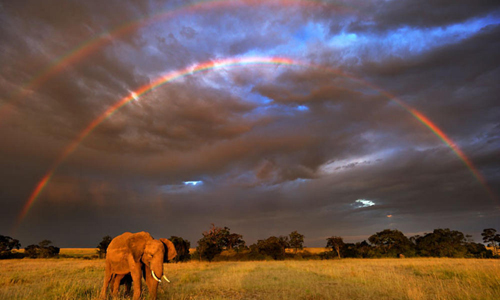 "The planet’s most majestic species are being massacred for nothing nobler than vacation trinkets, hangover remedies and false: promises of miracle cancer cures,” said Carter Roberts, President & CEO of WWF-US. “President Obama’s commitment to help stop the global crime wave that is emptying the continent’s forests and savannas is welcome news.” Photograph courtesy of WWF
"The planet’s most majestic species are being massacred for nothing nobler than vacation trinkets, hangover remedies and false: promises of miracle cancer cures,” said Carter Roberts, President & CEO of WWF-US. “President Obama’s commitment to help stop the global crime wave that is emptying the continent’s forests and savannas is welcome news.” Photograph courtesy of WWF
On 1 July 2013, U.S. President Barack Obama during a state visit to Tanzania declared in an executive order that “The poaching of protected species and the illegal trade in wildlife and their derivative parts and products (together known as "wildlife trafficking") represent an international crisis that continues to escalate.”
“Poaching operations have expanded beyond small-scale, opportunistic actions to coordinated slaughter commissioned by armed and organized criminal syndicates. The survival of protected wildlife species such as elephants, rhinos, great apes, tigers, sharks, tuna, and turtles has beneficial economic, social, and environmental impacts that are important to all nations.
“Wildlife trafficking reduces those benefits while generating billions of dollars in illicit revenues each year, contributing to the illegal economy, fueling instability, and undermining security. Also, the prevention of trafficking of live animals helps us control the spread of emerging infectious diseases.”
“President Obama’s commitment to help stop the global crime wave that is emptying the continent’s forests and savannas is welcome news,” said Carter Roberts, President & CEO of WWF-US. “It gives a critical boost for everyone involved in fighting wildlife trafficking—from rangers on the ground to local conservation groups to decision-makers around the globe.”
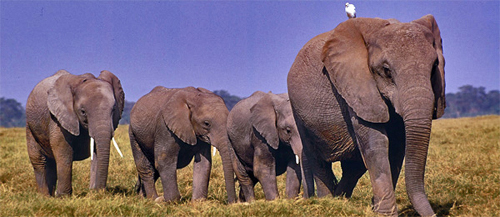
As summarized by the WWF President Obama’s Executive Order includes:
· A $10 million pledge to improve protection for threatened wildlife populations in key African countries.
· A Presidential Task Force on Wildlife Trafficking to develop a national strategy within six months to fight wildlife crime, which will receive recommendations from an Advisory Council on Wildlife Trafficking of independent experts. The focus of the task force will be on anti-poaching, regional law enforcement, law enforcement mechanisms, and reducing illicit trade and demand. Obama noted that the challenge does not reside within Africa alone, that the US must “seek to reduce the demand for illegally traded wildlife, both at home and abroad, while allowing legal and legitimate commerce involving wildlife.”
· A review of the federal government’s Transnational Organized Crime Strategy to consider adding wildlife trafficking to the list of crimes it covers, elevating it to the same level as arms, drug and human trafficking.
"The planet’s most majestic species are being massacred for nothing nobler than vacation trinkets, hangover remedies and false promises of miracle cancer cures,” said Roberts.
“These syndicates are robbing Africa of its wealth. President Obama’s commitment to help stop the global crime wave that is emptying the continent’s forests and savannas is … gives a critical boost for everyone involved in fighting wildlife trafficking – from rangers on the ground to local conservation groups to decision-makers around the globe.
“The future of our wild world rests in our hands, and now we must move with all due speed to make sure elephants, rhinos and other extraordinary creatures don’t disappear forever.”
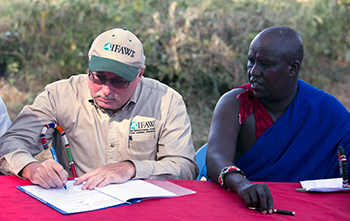 Azzedine Downes, International Fund for Animal Welfare (IFAW) President (left) and Mr. Daniel Leturesh, representing the Maasai: sign the Kitenden Corridor certificates after they signed a lease agreement, 17 July 2013, in Amboseli National Park in Kenya. Photograph © IFAW/K. Prinsloo.
Azzedine Downes, International Fund for Animal Welfare (IFAW) President (left) and Mr. Daniel Leturesh, representing the Maasai: sign the Kitenden Corridor certificates after they signed a lease agreement, 17 July 2013, in Amboseli National Park in Kenya. Photograph © IFAW/K. Prinsloo.
On 19 July 2013, in Africa, “an historic agreement for elephants in the creation of the Kitenden Corridor,” as reported by Azzedine Downes, International Fund for Animal Welfare (IFAW) President.
On Wednesday, July 17th, a ceremony was held in one of the most spectacular places on earth, watched over by Mount Kilimanjaro. Kilimanjaro is iconic. It is the highest, freestanding mountain in Africa, and pictures of elephants against a backdrop of Kili inspire thousands with a yen to see wild Africa to catch the first plane out.
Mount Kilimanjaro stands in Tanzania, just across the border from Kenya, where another equally gorgeous natural phenomenon occurs – Amboseli National Park, home to 1,400 elephants and myriad other wildlife including lion, cheetah, leopard, buffalo, wildebeest, antelope, giraffe and an array of birds.
Together, Amboseli and Kilimanjaro are the ultimate in spectacular Africa.
But Amboseli, and the elephants and wildlife that live in it, are under great threat. Amboseli is Kenya’s second smallest park, and cannot always cater to its huge herds of elephants.
Elephants roam miles daily – and even further afield in the rainy season – across the Maasai community lands, sometimes conflicting with local people.
The elephant’s most favourite route to travel, the journey they have made for millennia, is across the Tanzanian border and onto the slopes of the Kilimanjaro.
Over the years the establishment of “Group Ranches” around the borders of Amboseli has meant roaming space for elephants has slowly been eaten up.
In this video produced by the International Fund for Animal Welfare (IFAW), published on 23 July 2013, we hear from IFAW President and CEO, Azzedine Downes on the creation of the Kitenden Elephant Corridor in Kenya. On 17 July 2013, IFAW and the local Maasai community in Amboseli signed a lease agreement to create the corridor that effectively the National Park by 16,000 acres giving elephants space to roam free and safe. For more information go to http://ifaw.org.
On some of these farms the establishment of villages and small farms, and large herds of cattle have affected the habitat. Elsewhere, the threats of mining and commercial farming are very real.
Before it became too late, we needed to act to safeguard crucial habitat for elephants.
The only answer, which was reached after much discussion and on-going scientific research by the International Fund for Animal Welfare (IFAW) and its partners, was to lease land to extend Amboseli’s habitat and open up a safe corridor for the elephants to make their way to the border.
On the Tanzanian side, a similar corridor already exists so joining the two will ensure elephants can safely move between Amboseli and Kilimanjaro.
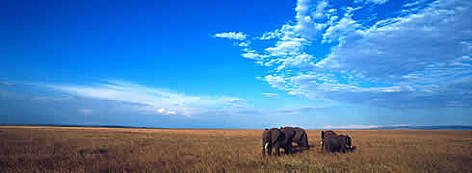 African elephant (Loxodonta africana) family group crossing the Masai Mara savanna, Kenya: Photograph courtesy and © WWF-Canon / Martin HARVEY
African elephant (Loxodonta africana) family group crossing the Masai Mara savanna, Kenya: Photograph courtesy and © WWF-Canon / Martin HARVEY
On Wednesday, 17 July 2013 IFAW signed a lease agreement with the community of the Olgulului-Ologarashi Group Ranch (OOGR) at Amboseli. This agreement frees up 16,000 acres of land called the “Kitenden Corridor.”
It is a profound and special moment for both IFAW internationally and our amazing team in the East Africa Regional Office, headed up by James Isiche.
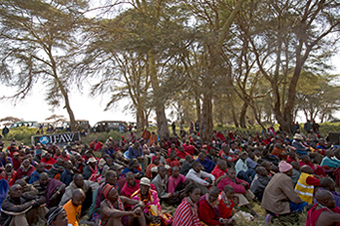 Many members of the Maasai community gather to watch the signing of a lease agreement: between IFAW and the Maasai community, 17 July 2013, Amboseli National Park, Kenya. © IFAW/K. Prinsloo
Many members of the Maasai community gather to watch the signing of a lease agreement: between IFAW and the Maasai community, 17 July 2013, Amboseli National Park, Kenya. © IFAW/K. Prinsloo
In signing this agreement we honor Maasai community values, as they have been protecting elephants and wildlife in Amboseli for close on 300 years.
Nearly 1,600 Maasai landowners, each of whom has signed a share certificate agreeing to the lease of the land, gathered at Engong Narok in Amboseli to witness the ceremony that has given elephants the vital space they need.
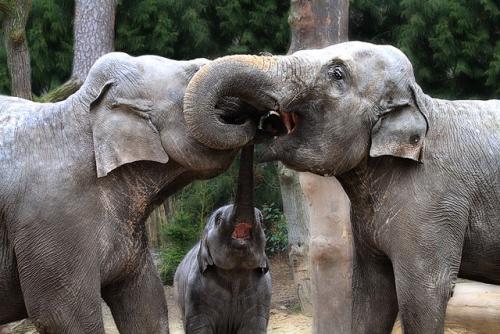 “Asian elephants greeting each other by inter-twining their trunks. Touching is an important form of communication: among elephants. Individuals greet each other by stroking or wrapping their trunks; the latter also occurs during mild competition....Touching is especially important for mother–calf communication. When moving, elephant mothers will touch their calves with their trunks or feet when side-by-side or with their tails if the calf is behind them. If a calf wants to rest, it will press against its mother's front legs and when it wants to suckle, it will touch her breast or leg.” Text from "Behavioral Ecology and Sociobiology" and photograph courtesy of Wikipedia.
“Asian elephants greeting each other by inter-twining their trunks. Touching is an important form of communication: among elephants. Individuals greet each other by stroking or wrapping their trunks; the latter also occurs during mild competition....Touching is especially important for mother–calf communication. When moving, elephant mothers will touch their calves with their trunks or feet when side-by-side or with their tails if the calf is behind them. If a calf wants to rest, it will press against its mother's front legs and when it wants to suckle, it will touch her breast or leg.” Text from "Behavioral Ecology and Sociobiology" and photograph courtesy of Wikipedia.
On 22 July 2013, Scientists from the Universities of Stirling, Oxford, Queensland and the Wildlife Conservation Society warn that current hunting trends in Central African forests could result in complete ecological collapse. In a report entitled, “Hunting Pushing Central African Forests Toward Ecological Collapse,” the authors claim that the loss of elephants, gorillas and other species threatens long-term persistence of forests.
The authors maintain that the current rate of unsustainable hunting of forest elephants, gorillas and other seed-dispersing species threatens the ability of forest ecosystems to regenerate, and that landscape-wide hunting management plans are needed to avoid an environmental catastrophe.
The study appears in the latest version of Philosophical Transactions of The Royal Society B. The authors include: K.A. Abernethy of the African Forest Ecology Group of Stirling University; L. Coad of the University of Queensland and the University of Oxford; G. Taylor of the University of Oxford; M. E. Lee of the Wildlife Conservation Research Unit and the University of Oxford; and Fiona Maisels of the Wildlife Conservation Society and the African Forest Ecology Group.
“Humans have lived in the forests of Central Africa for thousands of years, until recently practicing subsistence hunting for the needs of their communities,” said Kate Abernethy, lead author of the study. “Over the past few decades, this dynamic has drastically changed. Much of the hunting is now commercially driven, and species that play important ecological functions are being driven to local extinction.”
The researchers conducted a review of more than 160 papers and reports on the region’s wildlife declines, hunting trends, and land-use analyses by humans. The authors found troubling trends that threaten the very fabric of rainforest ecosystems. In particular, mammals such as forest elephants, gorillas, forest antelopes and others play a major role in seed dispersal for most tree species; the removal of these mammals by bushmeat hunters disrupts forest regeneration.
Furthermore, previously untouched swathes of forest are being penetrated by roads, and subsequently degraded by logging and agriculture. In other areas, forests are cleared and replaced by single-species plantations of oil palm, rubber trees, and crops for biofuels. The authors warn that such plantations greatly reduce areas available for seed dispersing wildlife.
“Another emerging problem for Central Africa’s forests is the migration of large numbers of people into remote forests, around the new plantations and the mining and logging camps,” said WCS Conservationist Fiona Maisels, a co-author on the study. “This population growth creates additional hunting pressures on previously lightly populated areas.”
The authors point out that good hunting management practices and planning must be included in any climate change strategy or land use plan in Central Africa. They add that efficiently managed multiple-use landscapes—combining protected areas alongside logging concessions—can maintain the seed-dispersing species while maintaining game species for hunting needs.
A top priority, the researchers assert, should be the protection of megafauna such as forest elephants and apex predators such as leopards in order to maintain intact ecosystems in Central Africa. Otherwise, the loss of wildlife will result in a disastrous spiral of forest degradation that will reduce the storage of carbon and the resilience of rainforests to climate change.
“Current climate models suggest that Central African rainforests may be more ecologically resilient to the short-term impacts of climate change than those of West and East Africa, or the Amazon,” said co-author Dr. Lauren Coad. “However, severe ecological changes below the forest canopy, driven by hunting, are already occurring. The removal of seed-dispersing megafauna such as elephants and apes could reduce the ability of forests to sequester carbon.”
“The clock is ticking on the future of large mammals in Central Africa’s Congo Basin Rainforest, and with them on the future of the forests themselves and all the people who depend on them,” said Dr. James Deutsch, Executive Director of WCS’s Africa Program. “The people, the forests, and the wildlife need an emergency effort to bring illegal and unsustainable hunting under control.”
Much of the data analyzed for this study was collected with the support of the US Fish & Wildlife Service and USAID's Central Africa Regional Program for the Environment.
Amazing Wildlife Images from Thailand's Western Forest Complex
“An amazing collection of images was captured by camera trap video by WCS and the Government of Thailand in Huai Kha Keng Wildlife Sanctuary in 2011. These show the incredible diversity of species that can flourish once the proper protections are in place.” From WCS, 19 December 2011
On 12 August 2013, designated World Elephant Day, WWF and TRAFFIC reported that they urged Thailand’s Prime Minister, Yingluck Shinawatra, to ensure legal reform, including steps outlined in Thailand’s National Ivory Action Plan agreed to at the CITES in May.
In order for Thailand’s Plan to satisfy the requirements of the CITES decision and deliver on the commitment from the Prime Minister, WWF and TRAFFIC believe it must provide for legislation that is sufficiently robust to prevent the sale of ivory within Thailand; forensic testing of large ivory seizures; and, a comprehensive registration system for domestic elephants.
On August 8th, Prime Minister Shinawatra visited Kuiburi National Park in southwest Thailand, a stronghold for about 230 wild Asian elephants along with other endangered species, including tigers, gaur, banteng, and Malayan tapir.
The Prime Minister also recently returned from Tanzania, where she signed a memorandum of understanding for cooperation on national park and wildlife management and visited Serengeti National Park where elephants are being killed for their ivory, much of which is potentially destined for Thailand.
Although it is against the law to bring ivory from African elephants into Thailand and to sell ivory from wild Asian elephants in Thailand, current law allows for ivory from domestic Thai elephants to be sold legally. As a result, massive quantities of African ivory can be laundered through Thai shops. To save Africa’s elephants it is essential that Thailand address this issue.
“Ending ivory trade in Thailand – currently the world’s largest unregulated ivory market – will go a long way in stemming a global poaching crisis that is leading to the slaughter of tens of thousands of elephants each year and fuelling a global criminal trade in animal parts,” said TRAFFIC’s Greater Mekong Programme Coordinator, Dr Naomi Doak.
“Perhaps as few as 2,500 wild elephants are left in Thailand. That’s as many elephants as were wiped out each month in Africa in 2012,” said Janpai Ongsiriwittaya, Illegal Wildlife Trade campaign leader in WWFThailand.
“Thanks to the tireless efforts of rangers patrolling Kuiburi National Park, no elephants have been lost due to poaching since 2010. But demand for ivory is immense, so while it’s Africa’s elephants slaughtered today, it could be Thailand’s elephants tomorrow.”
Elephants' Painting 【タイ】ゾウの天才的な絵画
This video was taken in Maesa Elephants Camp in Chiang Mai, Thailand. Elephants were painting beautiful pictures. Uploaded 25 September 2011
The Truth about Elephant Paintings
This is a video of an elephant painting made by a friend who has recently visited Thailand. I had heard about elephants painting abstract pictures, but I didn't know they would go as far as painting an object, so I got intrigued by it and did a bit of research, which I added to the video. Uploaded 18 December 2011
About the Convention on the International Trade of Endangered Species (CITES):
With 178 Member States, CITES remains one of the world's most powerful tools for biodiversity conservation through the regulation of trade in wild fauna and flora. Thousands of species are internationally traded and used by people in their daily lives for food, housing, health care, ecotourism, cosmetics or fashion. CITES regulates international trade in close to 35,000 species of plants and animals, including their products and derivatives, ensuring their survival in the wild with benefits for the livelihoods of local people and the global environment. The CITES permit system seeks to ensure that international trade in listed species is sustainable, legal and traceable.
CITES was adopted in Washington D.C. on 3 March 1973.
Read more:
· CITES Secretary-General expresses grave concern over reports of mass elephant killings in Cameroon
Learn more about CITES by visiting www.cites.org or connecting to:
www.facebook.com/cites
www.twitter.com/citesconvention
www.youtube.com/citesvd
www.flickr.com/cites
Subscribe to Azzedine Downes, IFAW President and Chief Executive Officer
About IUCN http://www.iucnredlist.org/details/12392/0
Poaching for ivory and meat has traditionally been the major cause of the species' decline. Although illegal hunting remains a significant factor in some areas, particularly in Central Africa, currently the most important perceived threat is the loss and fragmentation of habitat caused by ongoing human population expansion and rapid land conversion. A specific manifestation of this trend is the reported increase in human-elephant conflict, which further aggravates the threat to elephant populations.
IUCN Red List:
http://www.iucnredlist.org/details/12392/0
Poaching for ivory and meat has traditionally been the major cause of the species' decline. Although illegal hunting remains a significant factor in some areas, particularly in Central Africa, currently the most important perceived threat is the loss and fragmentation of habitat caused by ongoing human population expansion and rapid land conversion. A specific manifestation of this trend is the reported increase in human-elephant conflict, which further aggravates the threat to elephant populations.
About TRAFFIC:
TRAFFIC, the wildlife trade monitoring network, works to ensure that trade in wild plants and animals is not a threat to the conservation of nature.
About The Wildlife Conservation Society (WCS) The WCS saves wildlife and wild places worldwide. We do so through science, global conservation, education and the management of the world's largest system of urban wildlife parks, led by the flagship Bronx Zoo. Together these activities change attitudes towards nature and help people imagine wildlife and humans living in harmony. WCS is committed to this mission because it is essential to the integrity of life on Earth. Visit www.wcs.org.
WCS: http://www.wcs.org/elephants/
Links to WCS elephant descriptions, research and preservation efforts:
African forest:
http://www.wcs.org/saving-wildlife/elephants/african-forest-elephant.aspx
African savannah:
http://www.wcs.org/saving-wildlife/elephants/savannah-elephant.aspx
Asian: http://www.wcs.org/saving-wildlife/elephants/asian-elephant.aspx
http://wwf.panda.org/what_we_do/endangered_species/elephants/african_elephants/
About WWF: WWF's mission is to conserve nature and reduce the most pressing threats to the diversity of life on Earth. Our vision is to build a future where people ive in harmony with nature.
http://worldwildlife.org/species/elephant
Send a Postcard to an Elephant Ranger | World Wildlife Fund
Send a postcard thanking rangers for protecting elephants from illegal wildlife crime.
wwf.worldwildlife.org/site/PageServer?pagename=Thank_Ranger...
They [rangers] serve under various titles—rangers, forest guards, eco guard and field enforcement officers—but these men and women on the frontlines ... worldwildlife.org/stories/back-a-ranger
Wikipedia at provides a list of national parks in Africa (a variety of parks, not just with elephants) available at http://en.wikipedia.org/wiki/List_of_national_parks_in_Africa.
Search
Latest articles
Agriculture
- World Water Week: Healthy ecosystems essential to human health: from coronavirus to malnutrition Online session Wednesday 24 August 17:00-18:20
- World Water Week: Healthy ecosystems essential to human health: from coronavirus to malnutrition Online session Wednesday 24 August 17:00-18:20
Air Pollution
- "Water and Sanitation-Related Diseases and the Changing Environment: Challenges, Interventions, and Preventive Measures" Volume 2 Is Now Available
- Global Innovation Exchange Co-Created by Horizon International, USAID, Bill and Melinda Gates Foundation and Others
Biodiversity
- It is time for international mobilization against climate change
- World Water Week: Healthy ecosystems essential to human health: from coronavirus to malnutrition Online session Wednesday 24 August 17:00-18:20
Desertification
- World Water Week: Healthy ecosystems essential to human health: from coronavirus to malnutrition Online session Wednesday 24 August 17:00-18:20
- UN Food Systems Summit Receives Over 1,200 Ideas to Help Meet Sustainable Development Goals
Endangered Species
- Mangrove Action Project Collaborates to Restore and Preserve Mangrove Ecosystems
- Coral Research in Palau offers a “Glimmer of Hope”
Energy
- Global Innovation Exchange Co-Created by Horizon International, USAID, Bill and Melinda Gates Foundation and Others
- Wildlife Preservation in Southeast Nova Scotia
Exhibits
- Global Innovation Exchange Co-Created by Horizon International, USAID, Bill and Melinda Gates Foundation and Others
- Coral Reefs
Forests
- NASA Satellites Reveal Major Shifts in Global Freshwater Updated June 2020
- Global Innovation Exchange Co-Created by Horizon International, USAID, Bill and Melinda Gates Foundation and Others
Global Climate Change
- It is time for international mobilization against climate change
- It is time for international mobilization against climate change
Global Health
- World Water Week: Healthy ecosystems essential to human health: from coronavirus to malnutrition Online session Wednesday 24 August 17:00-18:20
- More than 400 schoolgirls, family and teachers rescued from Afghanistan by small coalition
Industry
- "Water and Sanitation-Related Diseases and the Changing Environment: Challenges, Interventions, and Preventive Measures" Volume 2 Is Now Available
- Global Innovation Exchange Co-Created by Horizon International, USAID, Bill and Melinda Gates Foundation and Others
Natural Disaster Relief
- STOP ATTACKS ON HEALTH CARE IN UKRAINE
- Global Innovation Exchange Co-Created by Horizon International, USAID, Bill and Melinda Gates Foundation and Others
News and Special Reports
- World Water Week: Healthy ecosystems essential to human health: from coronavirus to malnutrition Online session Wednesday 24 August 17:00-18:20
- STOP ATTACKS ON HEALTH CARE IN UKRAINE
Oceans, Coral Reefs
- World Water Week: Healthy ecosystems essential to human health: from coronavirus to malnutrition Online session Wednesday 24 August 17:00-18:20
- Mangrove Action Project Collaborates to Restore and Preserve Mangrove Ecosystems
Pollution
- Zakaria Ouedraogo of Burkina Faso Produces Film “Nzoue Fiyen: Water Not Drinkable”
- "Water and Sanitation-Related Diseases and the Changing Environment: Challenges, Interventions, and Preventive Measures" Volume 2 Is Now Available
Population
- "Water and Sanitation-Related Diseases and the Changing Environment: Challenges, Interventions, and Preventive Measures" Volume 2 Is Now Available
- "Water and Sanitation-Related Diseases and the Changing Environment: Challenges, Interventions, and Preventive Measures" Volume 2 Is Now Available
Public Health
- Honouring the visionary behind India’s sanitation revolution
- Honouring the visionary behind India’s sanitation revolution
Rivers
- World Water Week: Healthy ecosystems essential to human health: from coronavirus to malnutrition Online session Wednesday 24 August 17:00-18:20
- Mangrove Action Project Collaborates to Restore and Preserve Mangrove Ecosystems
Sanitation
- Honouring the visionary behind India’s sanitation revolution
- Honouring the visionary behind India’s sanitation revolution
Toxic Chemicals
- "Water and Sanitation-Related Diseases and the Changing Environment: Challenges, Interventions, and Preventive Measures" Volume 2 Is Now Available
- Actions to Prevent Polluted Drinking Water in the United States
Transportation
- "Water and Sanitation-Related Diseases and the Changing Environment: Challenges, Interventions, and Preventive Measures" Volume 2 Is Now Available
- Urbanization Provides Opportunities for Transition to a Green Economy, Says New Report
Waste Management
- Honouring the visionary behind India’s sanitation revolution
- Honouring the visionary behind India’s sanitation revolution
Water
- Honouring the visionary behind India’s sanitation revolution
- Honouring the visionary behind India’s sanitation revolution
Water and Sanitation
- Honouring the visionary behind India’s sanitation revolution
- Honouring the visionary behind India’s sanitation revolution

